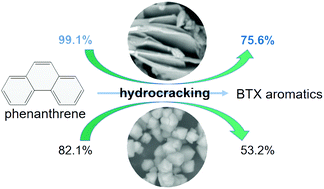High-efficiency hydrocracking of phenanthrene into BTX aromatics over a Ni-modified lamellar-crystal HY zeolite†
Abstract
A new Ni–HY zeolite with lamellar-crystals was prepared as a catalyst for phenanthrene hydrocracking. It showed significantly improved reactivity and BTX (benzene, toluene and xylene) selectivity (up to 99.1% and 75.6%, respectively), depending on a reasonable synergistic effect between its excellent internal-diffusion and the high-efficiency concerted catalysis of surface metal–Ni active sites and acid sites. In particular, compared with a conventional Ni–HY with diamond-shaped crystals, its significantly shortened diffusion-reaction path of the micropore system in the lamellar crystals greatly enhanced the diffusion-reaction efficiency of large-molecule phenanthrene and polycyclic intermediates and remarkably improved the utilization of both pores and internal reactive sites, powerfully promoting phenanthrene into benzene series conversion. The much decreased diffusion-residence time of benzene-series products in shortened channels also effectively weakened the further cracking loss of the benzene-ring, leading to enhanced BTX selectivity. Moreover, this shorter-channel Ni–HY catalyst with a higher external surface area and mesoporous volume also exhibited greatly improved catalytic stability attributed to its stronger capabilities of accommodating coke and resisting coke-deposition. The phenanthrene conversion of >76.3% and the BTX yield of >46.3% were obtained during a 60 h on-stream reaction.



 Please wait while we load your content...
Please wait while we load your content...